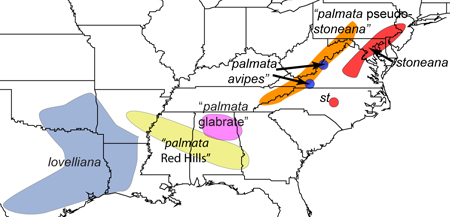Viola palmata-glabrate
Common names:
None.
Synonyms:
None.
Description:
Foliage essentially glabrous or sparsely hirsute (especially on petioles and lower surface of leaf blades), green, margins of leaf blades eciliate or sparsely ciliate, peduncles glabrous; larger leaf blades deeply pedately divided into 5 linear-lanceolate to lanceolate lobes, the terminal primary division undivided, the lateral primary divisions deeply divided, sinuses between primary divisions reaching nearly to the petiole summit; calyx eciliate or sparsely ciliate; lowest sepals lance-triangular, acuminate; cleistogamous capsule heavily purple-spotted or blotched, on an initially prostrate peduncle arching upward abruptly just prior to dehiscence; seeds are unknown.
Ecology:
Drier to moist sandy loam in dry-mesic to somewhat mesic woodlands.
Distribution:
Narrowly distributed in n. AL and nw. GA.
Rarity:
None.
Phenology:
Phenology presumably the same as V. palmata sensu lato.
Affinities:
This species belongs to the Acaulescent Blue Violet lineage, sect. Nosphinium W.Becker, subsect. Boreali-Americanae (W.Becker) Gil-ad, in the Palmata species group.
Hybrids:
None.
Comments:
This distinctive narrow endemic is poorly known and should be sought in the extreme southern Appalachian Mountain region and adjacent areas of other states. It is easily identified by the nearly glabrous or glabrate foliage and ovate-triangular acuminate sepals.
Literature Cited:
None.

Chasmogamous flowering habit from herbarium specimen: AL, Winston Co., along E. fork of Sipsey R. 2-1/4 mi. ESE of Addison, Deciduous woods on long steep slopes, 10 Apr 1953, W. H. Duncan 15316 & J. W. Hardin (GA189177)

Chasmogamous flower profile view from herbarium specimen: AL, Winston Co., along E. fork of Sipsey R. 2-1/4 mi. ESE of Addison, Deciduous woods on long steep slopes, 10 Apr 1953, W. H. Duncan 15316 & J. W. Hardin (GA189177)

Map of regionally endemic taxa in the Palmata species group by Harvey Ballard